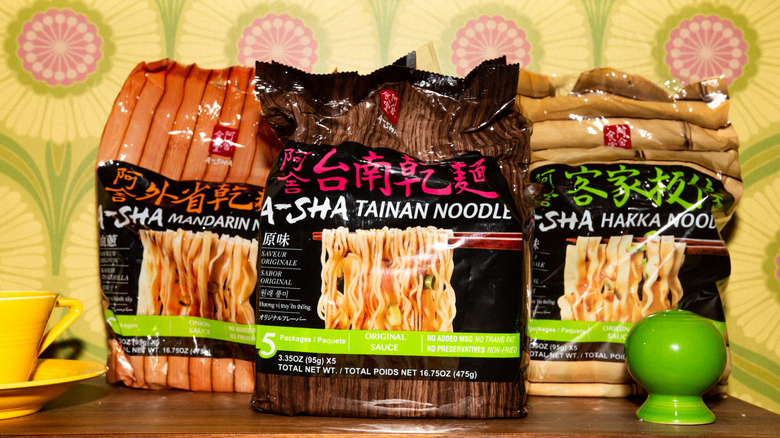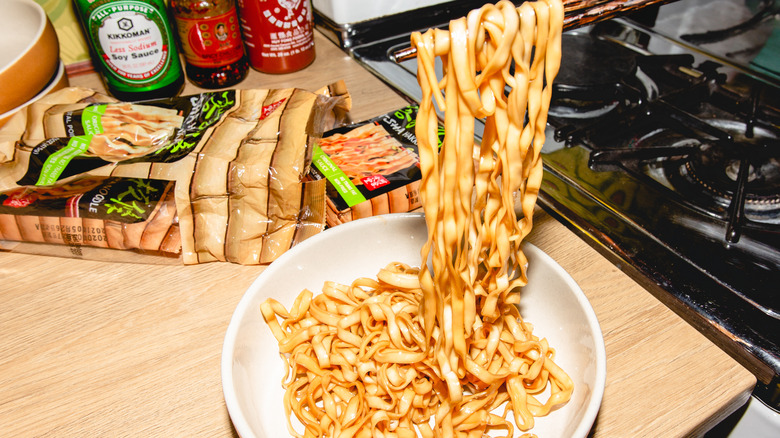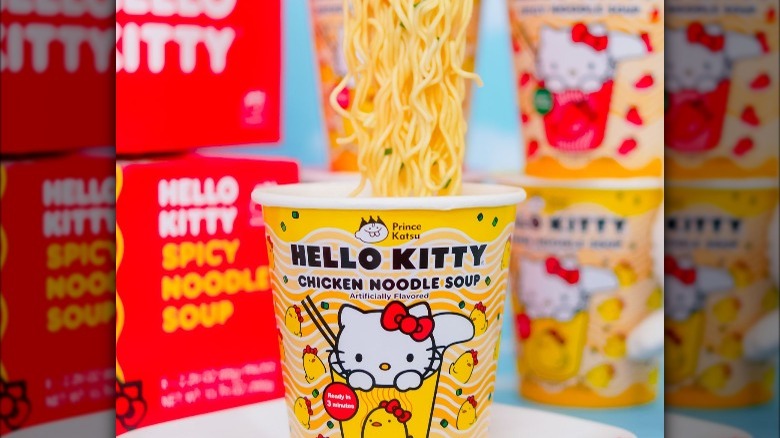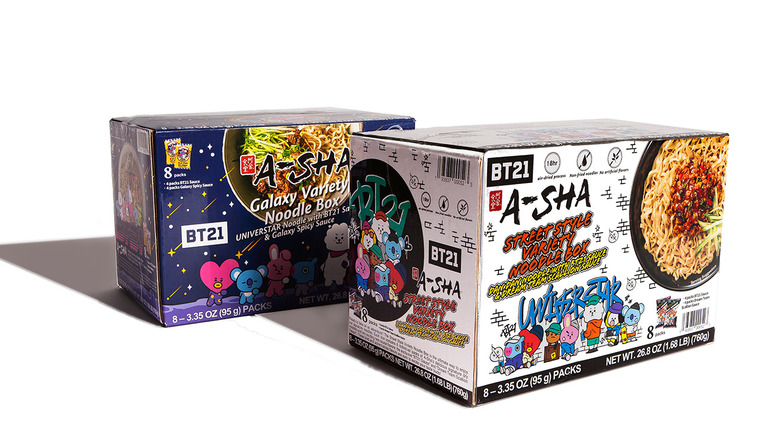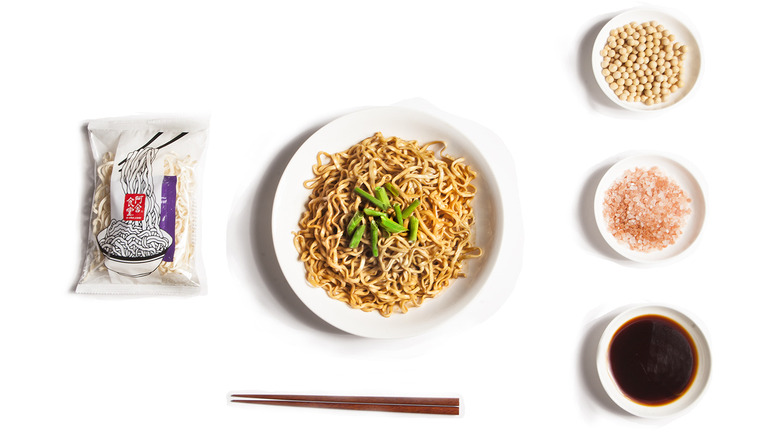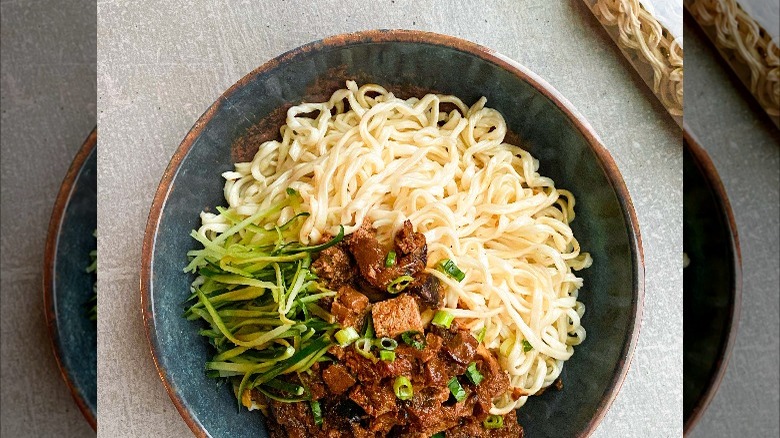How A-Sha Noodles CEO Young Chang Is Reinventing Ramen - Exclusive Interview
If you're no stranger to picking up a few packs of ramen during your weekly grocery run, then you may have spied A-Sha Noodles' attractive packaging, offering a range of noodle styles alongside the brand's original soy sauce, or you might've spotted one of the brand's more colorful collaborations featuring Sanrio characters, like Hello Kitty. However, if you've never actually experienced A-Sha Noodles for yourself, you may not know that this ramen brand isn't like the others.
A-Sha Noodles CEO Young Chang — who left a career with companies like Walt Disney, Warner Brothers, and IBM to run the family noodle business — calls the brand "a disruptor in the industry," and for good reason. A-Sha employs a 100-year-old noodle recipe that requires air-drying (not frying or freezing). The noodles pack 10 grams of plant-based protein per serving. The brand frequently collaborates with other well-known brands and characters, ranging from Sanrio to Momofuku's David Chang, and now, BT21.
But despite all these factors that make A-Sha stand apart, the brand still provides the same quick cooking process and convenience that you expect from ramen. In an exclusive interview, Mashed spoke with Chang to learn more about A-Sha's decision to break away from the typical idea of ramen, its latest offerings, and what fans can expect in the future.
Disrupting an industry
For our readers who maybe aren't familiar with A-Sha Noodles, how would you describe what to expect from the brand?
[With] A-Sha Noodles, what we're trying to do is be a disruptor in the industry. Everyone has preconceived notions of what ramen noodle is and, traditionally, what it always has been. My [preconception], growing up in the States, has always been [that it's] a cheap food, [a] belly stuffer ... Everyone has their own personal moments that they've had with ramen, where maybe it got us through tough times, or when we're cramming for finals. It's a quick meal, but it was never viewed as a high-end or premium product.
Our main thing is, we want to change the narrative on that, and we do it in a little bit of a different way. Instead of trying to create a new type of ramen, we're taking an old recipe that's 100 years old from Taiwan, and we're introducing it to the world. I feel like food from back then, from back in the day, was a lot healthier than what it is today. We have a lot of built-in things that natively are part of our product, like the air-dried factor and no MSG. All those things that people want, they're already in our product, so we didn't have to change it too much.
We aim to stick to what we do, do what we do best, and then bring it to people, and have the marketing and the distribution behind it to be able to get it to people's bowls.
Can you expand a little bit more on the 100-year-old recipe and the air-drying process? What's so special about that?
If you think about how food was made back in the day, there wasn't all this technology. People used real ingredients — flour, salt, water. That's our noodle base recipe. Our sauce is very simple. It's literally soy sauce and sesame oil. And people think, "Well, that's easy. I can make that too." That is very true. Chinese cultures have been making this style [of] noodle for many, many years. [But] for our particular recipe, [and] the type of soy sauce we use, and the different proportions that we use, that recipe's been passed down. That's the 100-year-old recipe for our brand, and we keep it the same.
Sure, we're moving [and] we're trying to be progressive as well — getting the non-GMO certification, reducing sodium, and all that — but our best seller is still the base noodle that's always been there. We've heard it from several of our customers and our buyers: "This one's really good. Try not to play around with this one too much because it's a winner."
Also, because we use the highest level of flour ... that wheat flour yields extremely high protein for a plant-based product. Before plant-based protein was popular, we were already a plant-based protein, and we didn't really even know it. ... Once those food trends started catching up, we said, "Oh, by the way, we are in that category as well."
I'm obviously very biased towards our product, but I love it.
Doing things differently
You already had a career before this, so what made you choose to go with noodles? Why would you want to switch gears to focus on this?
That is more about me personally as an entrepreneur and what I wanted to do with my career. I had amazing jobs at the Walt Disney Company, Warner Brothers, IBM, and a lot of Fortune 100 companies. But in the end, I went to business school, and I caught that entrepreneur bug. I went to [the] University of Southern California, and that university is known to breed entrepreneurs and a lot of business starters. I caught the bug, and I was always looking for an opportunity.
When one of my family members took over this factory in Taiwan, he bought it with a vision, which is [that] we have a really good product, and [we] want to take it to the rest of the world.
That wasn't necessarily something that I wanted to do, but he was talking to me and pursued me for three years. A lot of times, with business, you can partner with certain people, but when it's someone in your family and someone that you trust, it makes everything easier. He was really adamant about, "Hey, we need to do something with this company."
I finally bit the bullet and was like, "All right, let's give it a go and see what happens." I started importing it, and then I fell into the food business. It wasn't my calling, and it wasn't what I was trained to do. I'm from a computer science background, so I'm very tech-heavy, but food is just so fun. I feel like it touches so many people because, if you think about it, this is something that actually goes into people's bodies. They are consuming it. It's a very intimate product, in that sense.
With the type of food that we're putting on people's plates — and a lot of time, that people are serving to their children — you have to be very responsible with what you're doing. The challenge of that, and the challenge of convincing people, "I have this very ethnic product, but I think you'd like it" — that whole challenge brought my business education and all those things that I learned as far as being an entrepreneur, launching a brand, positioning, and all that fun stuff, full circle.
I will admit that [I] and my partner, we are not from the food business. We don't have tens of years at PepsiCo or Nestle. We are fresh in this industry. I think that was one of our advantages, because we thought about food very differently from traditional businesses. We thought about it from a branding and marketing [perspective], and more of a ... whole disruptor thing. We want to do things differently, and we are different because we're not from this industry. We're changing everything.
That segues into the whole Sanrio-BT21-Momofuku thing, which is our way of connecting with people. These entities all had their fan bases, and for us to do crossovers with them was such a great opportunity for us to introduce our product ... because there were a lot of like minds in their target audience and our target audience.
Hello Kitty survival food
Do you have a particular favorite brand collaboration that you've done?
I have to say that Hello Kitty was my favorite.
We never pursue these collabs. The collabs find us. The way that Sanrio and that partnership came about was because back in 2020, there was the Tokyo Olympics. [The Olympics] wanted to do something that was very representative of the culture, and also something that was hip and cool. Sanrio is so iconic, and it spans so many generations. It's one of those brands that ... [It's] probably [among the] top 10 most recognizable brand logos in the world, I would say. So Sanrio representing the Tokyo Games was perfect.
And then, what type of product would you want to represent that? I think noodles are a pretty good representation of Asian culture and Asian cuisine. [With] that partnership, we took it not knowing what was going to happen, but we thought it made so much sense, so we did it.
Of course, why that one meant so much to us was [also] because [the] pandemic happened shortly thereafter. [The collaboration] was originally supposed to be a one-year project, just for the 2020 Games. But, if you recall, the Games were postponed one year, so we actually had a two-year run with that product.
When the pandemic and the world were going crazy, that was the one product that we were continually pushing and getting out there. At that time, when we were on lockdown, things like ramen noodle ... It was, again, a survival food at that time for a whole other reason.
That product and that series mean so much because of all the other things that were happening along with it. The product itself was great. It's an amazing package, and it's been a terrific partnership, but that one really, because of everything else that was going on in the world, sticks out in my mind, because it was so essential at the time. It was one of those fun things that was happening when the world was going crazy.
Like a movie premiere for noodles
What inspired this new BT21 collaboration? Why was that something that you thought would be a good fit?
When you look at the different segments in the market, Sanrio still plays heavily towards the younger generation, but there are a lot of people my age that still remember, and my parents know, Hello Kitty. Everyone knows Hello Kitty because it is very generational.
BT21 is inspired by BTS. BTS is the crazy K-pop phenomenon, and that target audience is completely different from Hello Kitty['s]. There is some crossover, but it's a bit of a more mature crowd. Hello Kitty is something your parents would buy for you, but K-pop and BTS are something that I think we go for. We gravitate towards that. That whole target audience was new to us and different for us, so we were interested in that. When they came to us and said BTS actually drew these cartoon characters, and it's a collection called BT21 — which, truth be told, I had never heard of — I was like, "Oh, that's so cool."
And everyone loves BTS. McDonald's is collab-ing with them, and all these food brands are doing stuff. So I was like, "I would love to have our noodle be part of this ecosystem as well."
It made perfect sense, and we were fortunate to have really, really solid partners with Target. ... It's launching [in] the middle of this month at Target, so we're super excited about that. And with the whole BT21 machine, [the product is] on a billboard in Times Square. It's going to be at the [Line Friends] Hollywood store, and it's going to be at the [Line Friends] Times Square store. ... Line is a chatting app, and they own BT21, so they have stores in Hollywood [and] in Times Square, so they're going to be putting it in the stores. They're going to be having it on their website for sale as well.
It's going to be a very different style of launch. It's almost like a movie premiere, more so than anything. That's the way I equate it.
Do you have the exact date for the mid-October launch in Target?
I would say, by about October 20, it should be in all the stores that it's going to be in.
New noodle shapes
I know that the collaboration has resulted in a few different noodle varieties. Do you have a particular favorite?
BT21 has different series. They have a baby series; they have a street-style series. There are different poses and outfits that they draw the cartoons in. There's one that is called the Galaxy series. It just so happened that we had launched what we called the meteor noodle, so it was very serendipitous.
The reason why we created a meteor noodle is because, with most ramen, there's a single blade that cuts it, so it comes out flat and/or round. But what we did was we added a dual-blade technology onto our machine, so it actually created a 3D, and what we think is a star-shaped, noodle. When you look at it lengthwise, it looks like a star shape. There are five edges to it.
We just happened to call it a meteor noodle, and they had the Galaxy series, so we're like, "This is too perfect." So we put those two together.
I love the meteor noodle because the meteor noodle is so different. The 3D shape grips the sauce differently. The mouthfeel is totally different. I feel that the meteor noodle, in its own right, is innovating the ramen noodle, the base noodle industry, because ramen noodle hasn't changed much. Pasta has so many different shapes and sizes, but ramen noodle is always ramen noodle. Why is that the case? Ramen noodle is made very similarly to pasta, so we can do different shapes as well.
This is our first attempt, and the results have been amazing because we worked with so many different chefs, including the executive chef at Momofuku. Every time we've shared this noodle with them, they're like, "Wow, this is different. This is super, super unique."
So I'm excited about that one. That's the base noodle that's part of the BT21 [collaboration].
Upcoming collabs and Crazy Rich Ramen
Is there anything else coming up for the brand? Anything else that you'd like to share that we can look out for?
The Momofuku project is still doing amazing. We're in Whole Foods and we're in Target, so it's doing well, and it's so cool to work with Dave Chang because he's a Michelin-level chef. To have him and be able to send him samples and have him give us real feedback, it's been so amazing. If you follow the Momofuku Instagram, you see all the different things that they're doing with our noodles. ... Their team is so innovative and so creative, and they do so many different things.
As I mentioned, we don't really pursue collabs, but ... we have a lot of people asking us to do collabs now. Not every collab is the right one for us, but we've got a few on the horizon that we're talking to right now that are really, really exciting. I can't say what they are. I wish I could. I would love to announce to the world what it is, but we are still talking, and I hope that those get launched in probably Q1 or Q2 of next year. It's going to be really cool. We are constantly still really, really trying to change the narrative of ramen, [and] the people that we work with, the people that we want to partner with, are only going to help elevate us.
We also have a new product that's coming out for the holidays this year. It's called the Crazy Rich Ramen Box. We launched this back in February of this year, and we did a box with fresh caviar inside. We put it at $500, so it was a real WTF moment online, but that was the point.
For the next version that we have coming out, we partnered with a truffle company out of Brooklyn, and we're going to be doing a truffle ramen noodle. It's the first-ever truffle ramen box, and we're going to be launching that for the holidays. I hope that one is a really cool one. It's got this amazing box, it's all fitted, and it's matte black with gold foil. It looks really, really nice. It's something cool for the holidays, or maybe for couples to have a nice meal indoors and create something cool, like a truffle ramen.
I'm so excited about our story. I think about where we came from, which is a local Taiwanese factory, and our goal was ... to get this product into the mouths of everyone around the world. That's always been our objective. It's still our objective, and we try to collab with entities and brands that are popular in the U.S. to try to keep pushing that message. But we're always concerned about the product first and foremost, food safety, and the highest-quality ingredients. That's always been our guiding light for the way we do our products.
The A-Sha Noodles BT21 collection is available online and will launch in select Target stores in October.
This interview has been edited for clarity.
